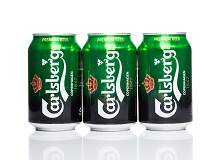
Mainstream brands that are deploying special effects include Carlsberg, which in 2010, introduced a new embossed bottle for the UK market to project a more premium image, and Heineken, which in June became the first beer brand to use tactile ink on its travel retail cans.
Meanwhile, Ball Packaging announced that it had brought digital printing for beverage cans to market maturity, enabling custom designs to be reproduced in photo-realistic quality. However, according to Breakthrough Innovations Manager at Rexam Beverage Can, Steve Howell, digital printing for beverage cans is still very much in embryonic form, and a more proven technology is ‘high definition’ printing, which is said to bring graphics to life through enhanced colour definition and photo-like quality.
Another device that adds to the aesthetic appeal of a product is the sleeve. "Sleeves’ all-over coverage and their ability to offer an unrivalled quality of print finish, with vibrant colours and intricate graphics, means they are becoming a key part of campaigns to raise product visibility and brand awareness on-shelf," says Jon Cowan, sales director at CCL Decorative Sleeves.
Sleeves for spirits: a polarisation of pack sizes
Sleeves are proving particularly popular with spirits brands, partly perhaps because it is possible to incorporate security features into a sleeve to minimise the threat of counterfeiting.
Examples of spirits brands that are embracing the sleeve include Remy Cointreau’s Passoa~ liqueur, which features a matt black coated bottle and paper label for a full body shrink sleeve developed by CCL Decorative Sleeves, and The Pernod-Ricard and Dita Group’s lychee liqueur, which has used sleeves from Sleever International on a collectable edition for bars, lounges and night-clubs.
The economic downturn is driving a polarisation in pack sizes. Dr Benjamin Punchard, Head of Packaging Research at Euromonitor International says: "Beverage producers are moving to bigger bulk buy sizes for cost reduction in commodity beverages, and moving to smaller sizes to reduce spend on higher end beverages."
How well do you really know your competitors?
Access the most comprehensive Company Profiles on the market, powered by GlobalData. Save hours of research. Gain competitive edge.

Thank you!
Your download email will arrive shortly
Not ready to buy yet? Download a free sample
We are confident about the unique quality of our Company Profiles. However, we want you to make the most beneficial decision for your business, so we offer a free sample that you can download by submitting the below form
By GlobalDataCarbonate value: better value for money
Examples of bigger ‘better value for money’ activity included the launch of Britvic‘s new 600ml format for carbonates such as Pepsi Max, Diet Pepsi, 7Up Free and Tango, and the introduction of a 0.75 litre glass bottle for SABMiller RUS’ Zolotaya Bochka brand in November 2009.
"This SKU was very well received by consumers, as it offers them an optimal pack size ‘when one is not enough and two is too much’ at an attractive price," says Corporate Affairs Director of SABMiller, Pawell Kwiatkowski.
Home innovations: recession-led trends
At the opposite end of the size spectrum, in 2010 Orangina Schweppes extended its Trina fruit still drink family in Spain to include a 27.5cl ‘baby’ PET bottle, and Coca-Cola launched in a 25cl ‘slim can’ in Germany.
The recession has also increased at-home consumption, and this in turn has stimulated innovation in home draught formats for beer.
"We’re seeing growth in keg formats that replicate draft at home – the Heineken keg by Impress has performed very well and we saw the introduction of a PET bottle-in-box format with gas canister attached to offer a more economical draft at home experience for Molson Coors," says Punchard.
Whether these recession-led trends will continue once Europe’s economies are back on an upwards curve remains to be seen.



